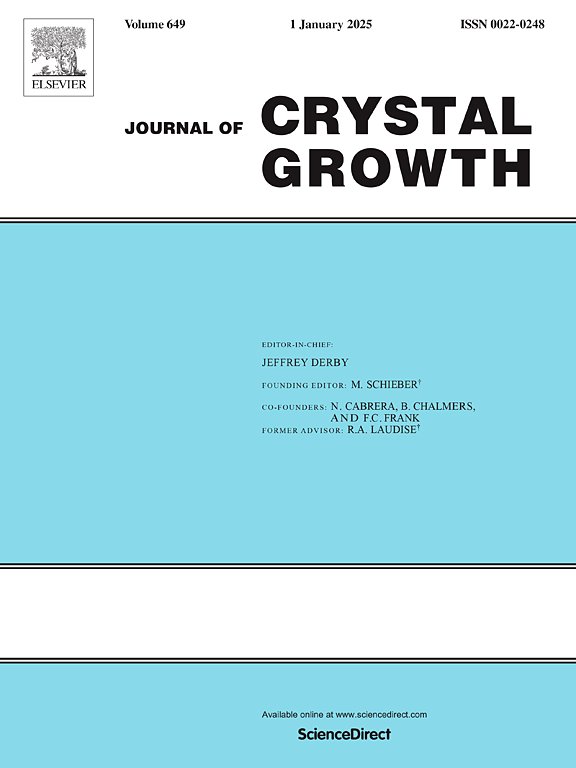在外来基底上生长外延薄膜的新方法 - Bent epitaxy
IF 1.7
4区 材料科学
Q3 CRYSTALLOGRAPHY
引用次数: 0
摘要
近年来,为减缓气候变化的影响,各国加快了向绿色经济转型的步伐,半导体行业对 SiC 和 GaN 等宽隙半导体的需求也因此大幅增加。这些半导体价格昂贵。为了降低最终产品的价格,正在开发在硅和蓝宝石等容易获得且廉价的基底上工业化生产所需的半导体外延薄膜。在国外基底上生长外延薄膜时,由于基底和外延薄膜的热膨胀系数(CTE)不匹配,产生的异质结构会弯曲、变凹或变凸。因此,外延薄膜的质量会下降,在生产线上进一步加工所产生的异质结构会变得困难甚至不可能。所建议的新方法的本质是,外延薄膜不是生长在平面上,而是生长在预弯曲的基底上,期望在将所制造的异质结构冷却到室温后,由于外延薄膜和基底的 CTE 不同,异质结构将呈现平面形状。位于基底下方的圆形双金属片可在生长温度下将基底向所需方向弯曲至所需值,并在冷却过程中根据外延薄膜的热收缩比例逐渐减小所制造异质结构的弯曲度。这样,无论基底或外延膜的材料如何,也无论基底的直径或外延膜的厚度如何,都能获得优质平整的外延膜,而无需任何缓冲层,也无需进行任何额外的操作和成本。本文章由计算机程序翻译,如有差异,请以英文原文为准。
A new method for growing epitaxial films on foreign substrates − Bent epitaxy
In recent years, to mitigate the effects of climate change, countries’ transition to the green economy has accelerated, and thereby, the demand of semiconductor industry for wide-gap semiconductors such as SiC and GaN has increased dramatically. These semiconductors are expensive. To reduce the price of the final product, industrial production of thin epitaxial films of sought-after semiconductors on accessible and cheap substrates, such as Si and sapphire, is being developed. When growing epitaxial films on foreign substrates, the resulting heterostructure bends, becomes concave or convex, due to a mismatch between the coefficients of thermal expansion (CTE) of the substrate and the epitaxial film. As a result, the quality of the epitaxial film deteriorates and further processing of the resulting heterostructures in production lines becomes difficult or even impossible. The essence of the proposed new method is that the epitaxial film is grown not on a flat, but on a pre-curved substrate with the expectation that after cooling the fabricated heterostructure to room temperature, the heterostructure will take a flat shape due to the difference in the CTE of the epitaxial film and the substrate. A round bimetallic plate, located under the substrate, bends the substrate in the required direction to the desired value at the growth temperature, and gradually reduces the bend of the fabricated heterostructure during cooling, in proportion to the thermal contraction of the epitaxial film. This allows obtaining qualitative and flat epitaxial films, regardless of the material of the substrate or epitaxial film and the diameter of the substrate or thickness of the epitaxial film, without any buffer layers or carrying out any additional operations and costs.
求助全文
通过发布文献求助,成功后即可免费获取论文全文。
去求助
来源期刊

Journal of Crystal Growth
化学-晶体学
CiteScore
3.60
自引率
11.10%
发文量
373
审稿时长
65 days
期刊介绍:
The journal offers a common reference and publication source for workers engaged in research on the experimental and theoretical aspects of crystal growth and its applications, e.g. in devices. Experimental and theoretical contributions are published in the following fields: theory of nucleation and growth, molecular kinetics and transport phenomena, crystallization in viscous media such as polymers and glasses; crystal growth of metals, minerals, semiconductors, superconductors, magnetics, inorganic, organic and biological substances in bulk or as thin films; molecular beam epitaxy, chemical vapor deposition, growth of III-V and II-VI and other semiconductors; characterization of single crystals by physical and chemical methods; apparatus, instrumentation and techniques for crystal growth, and purification methods; multilayer heterostructures and their characterisation with an emphasis on crystal growth and epitaxial aspects of electronic materials. A special feature of the journal is the periodic inclusion of proceedings of symposia and conferences on relevant aspects of crystal growth.
 求助内容:
求助内容: 应助结果提醒方式:
应助结果提醒方式:


